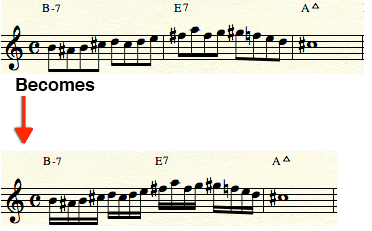Here’s a recent question from a reader struggling with fast tempos: “Hi, I’m a saxophone player in Toronto. What might you recommend in terms of practice techniques to play on blistering fast tempos?”
When it comes to fast tempos, we could all be better. Want to play fast? Start slow.
Slow over fast tempos
No matter how counter-intuitive it seems, you must first learn how to play slow melodic lines over fast tempos. These slow melodic lines consist primarily of half-notes and quarter-notes. Even when you’re not playing over fast tempos, resist the temptation to work more on playing fast than slow. Do not make the mistake of thinking that fast notes are more important than slow notes.
To play interesting slow melodic lines over fast tempos, think in larger units of time. Hearing in larger chunks of time will help you relax. How do you typically feel playing fast tunes? Frantic? Up-tight? Behind? To play confidently over quick tempos, you want to feel comfortable and relaxed.
Supposing we’re in 4, Rather than feeling every beat (1-2-3-4), feel just beat 1 of every measure. As each measure flies by, think to yourself “1…1…1…1…”
Or if the tune is really burning, think in even larger groups; feel only beat 1 every two measures. So for four measures where normally you’d feel 1-2-3-4 1-2-3-4 1-2-3-4 1-2-3-4, you would feel just 1 – – – – – – – 1 – – – – – – – .
Listen to Bud Powell play Cherokee in the video below and try to feel larger chunks of time, first groups of one measure and then groups of two measures. Note that the melody of Cherokee illustrates how to effectively use half-notes and quarter-notes over a fast tempo.
Now, feeling the larger units of time, practice playing half notes over the changes of a fast tune you’re working on. Treat it as more than exercise; act as if these half notes were your solo. Make it musical and meaningful. Do the same using quarter notes. Be careful not to rush or get up-tight. Stay relaxed. Then combine half-notes and quarter-notes, aiming to create lyrical lines through the changes.
As you get more comfortable, introduce triplets and sixteenths into a part of your half/quarter-note dominated melodic line (This can wait till later. See the steps st the end of the article). Let them creep in slowly by inserting them into only one beat. For example, in the span of four measures, play 7 half-notes and one group of 4 eighth notes. The whole goal of this exercise (starting with half-notes, quarter-notes, gradually introducing triplets and sixteenths) is to avoid playing a constant stream of aimless eighth notes.
Not only will practicing this exercise allow you to eventually play a constant stream of meaningful eighth notes, but it will also give you the ability to rhythmically develop your solos how ever you desire. Options are good.
Freddie Hubbard has complete mastery over rhythmic development. Listen to Freddie play over The Night Has a Thousand Eyes. Pay special attention to how he begins his solo, creating long lyrical lines and gradually working up to eighth notes.
Learn to rest
Other than the inclination to play a constant stream of eighth notes, fast tempos scream at us, “Play! Come on! Play more!!” Rather than conform to what the tempo orders you to do, learn to rest on command.
This ability is infinitely more difficult at fast tempos, so start simply. Practice both your slow-line playing and resting simultaneously by playing a half-note/quarter-note line for 4 measures and resting for the following 4 measures.
Experiment by combining different lengths of playing and resting, aiming to feel completely comfortable with slow melodic lines and resting over a fast tempo, while not losing your place in the chord changes.
Check out how Miles rests on command, framing and defining his ideas.
The importance of jazz language
When we play fast, the time to think about what to play dramatically decreases, and consequently, what we know best will surface. What can you play without thinking? Do you clam up and run up and down scales when you encounter a fast tempo? If you do, it’s because you know scales better than the jazz language.
If you do not want to aimlessly run up and down scales, learn bits of jazz language so well that you have them at your fingertips in all keys without thinking.
Many people look down upon memorizing lines and utilizing them when you solo. Their attitude is partly correct. Yes, memorizing lines and regurgitating them when you improvise, is not improvisation. The mistake these regurgitators make is they stop too early in the process.
When you first acquire a line in all keys and are able to hear it & play it in the context of a tune, you’ve only just begun. Although that’s a lot of work in itself and is a fabulous start, the goal with a piece of jazz language is to be able to use it as a springboard for your own creativity in the moment. The idea is to be able to hear infinite variations based upon that line in real-time and/or hear combinations of that line with other lines.
After you get a line under your fingers in all keys and can use it in tunes, spend time varying the line based upon what you hear. Start slowly. Hear every interval in the line. See how many variations you can improvise in 20 minutes. If you stumble upon any gems, write them down and put them in all keys.
Or try combining the line with other lines you’re working on and you’ll see how something new is produced just by this simple combination. Another thing to experiment with is to simply add some approach notes to the line, or tag on some notes to the end of the line. Often you have to do very little to a line to make it your own.
Double timing over slow and medium tempos
To get your lines up to speed so they will work at fast tempos and to get your ear hearing at faster tempos, first work on creating double-time passages at slower tempos.
To do this, pick a two-measure ii V line that you’ve learned straight from a recording (I’ve purposefully put very common lines in the examples to remind and encourage you to transcribe your own). Now, instead of playing it as eighth notes over two measures, play it over one measure as sixteenths as illustrated in the following example:
Another way to begin double-timing is to take a one-measure line and condense it by inserting two beats of rest before it as shown in the following example:
Both exercises will get you double-timing instantly. Make sure to keep your fingers, articulation, air stream, or anything else having to do with the technical aspects of your instrument in check. Only go as fast as you can while maintaining perfection.
Playing over fast tempos
So, to play over fast tempos:
- Work on creating half-note melodic lines.
- Work on creating quarter-note melodic lines. Feel relaxed and comfortable playing lines combining half-notes and quarter-notes.
- Work on resting. Play for 4 bars, then rest for four bars.
- Try different combinations of playing and resting.
- Review some jazz language you’ve learned from a recording. If you haven’t started practicing any language, start to do so.
- Practice double-timing over slower tempos. Pick a 2 measure ii V and play it twice as fast in the space of one measure. Then take a one measure line, insert two beats of rest before it, and play it twice as fast. Watch your technique.
- Gradually, introduce triplets and sixteenths into your melodic line practice you did in step 1. Again, watch your technique.
- Apply the jazz language you double-timed in step 6 to faster tempos, but now it won’t be double-timed. Playing the line as eighth notes at a fast tempo should be a similar speed as double-timed at a slower tempo.
- Make sure to practice improvising variations of transcribed jazz language, based upon what you hear. Get beyond regurgitation. Use transcribed lines as a foundation for your own creativity.
- Combine all the concepts discussed in your own creative way to begin to improvise confidently over fast tempos.












